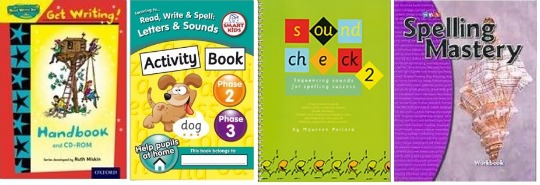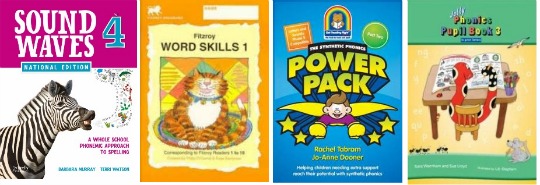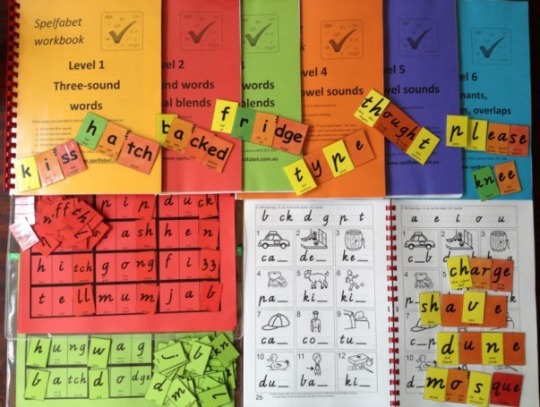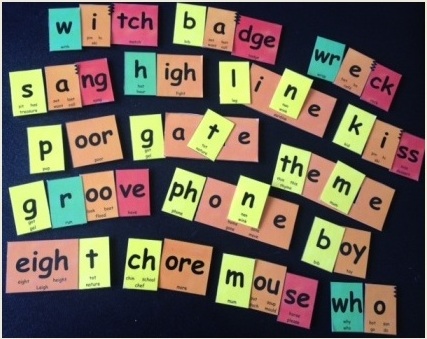Today’s guest post is a must read for all parents and form part of the literacy series of posts I am running throughout February. With literacy rates in Australia falling, as parents we really need to start questioning how our kids are being taught at school. The post is written by a Melbourne Speech Pathologist, Alison Clarke. I have known Alison for over 10 years and she has recently started a fab blog called Spelfabet. I would highly recommend her professional services if you are in the Clifton Hill (Vic) area of Melbourne.
This post will help you assess how your kids are being taught spelling at school, how do determine where your kids are at with spelling and what resources are available to your kids need more structured spelling tuition.
***********

A lot of my local schools only teach a fairly small subset of the spelling patterns of English, and in a fairly random fashion.
Very few use a whole-of-school spelling program like Sound Waves, or such a program embedded into a broader, explicit, synthetic phonics reading and spelling program.
Such programs start from sounds and their spellings (not words) and build them into words, teaching all the main spelling patterns of English in a systematic way, for both reading and spelling.
If you know your child’s school has a program like this, relax, you don’t need to read the rest of this post. But if you’re not sure, read on for ideas on how to make sure your child is getting the structure and practice they need to learn to spell well.
Spelling lists should make a point about spelling
My local learners are often given spelling lists and spelling tests, but often the words on them are not related by spelling. They thus don’t really teach anything useful about spelling, except perhaps “English spelling is pretty random”, which is far from the truth.
Such lists are really vocabulary lists, not spelling lists at all. Too often, learners are being left to work out most of the complex spelling patterns of English for themselves.
This is a hangover from the throwing-phonics-out-with-the-bathwater that happened in the 1960s and 1970s, when any kind of teacher-led activity was deemed not child-centred enough, and the teacher’s role was recast as facilitator of child-led discovery of how the world works.
This was no doubt well-meaning, but its consequences are now often in the news – for a recent example, click here. It’s not a happy story, for individuals, or the whole society.
Find out how your child’s school tackles spelling
It’s pretty easy to find out whether your child’s school is teaching spelling in a systematic way.
First, ask them whether they use a commercially-available program that sets out when all the spelling patterns of English are to be taught, from the “a” in “cat”, “man” and “bad” all the way up to the “ce” in “ocean”, “herbaceous” and “crustacean”, the “que” in “mosque”, “boutique” and “oblique”, and the “t” in “ballet”, “buffet” and “nougat”.
I asked one of my favourite primary school Principals this question the other day, and first she looked puzzled, and then she said, “No, we don’t. Oh. Maybe we should”. So I’ll be adding water and fertilizer to that little seed I’ve planted whenever I can.
Your school might be using a really good spelling program that they’ve made up themselves, but which you can’t buy anywhere, or read about on the internet.
To find out whether this is happening, ask the teachers or Principal which year they teach children a few specific spelling patterns. For example, ask when they teach:
- the “a…e” in “sale”, the “ai” in “sail” and the “ay” in “say”,
- the “dge” in “fridge”, “smudge” and “edge”,
- the “oi” in “soil” and the “oy” in “boy”,
- doubling of consonants, as in “button”, “winner” and “digging”,
- the “ti” in “motion”, “patient” and “Martian”,
- the “i…e” in “sardine”, “marine” and “machine”.
If you want to choose your own spelling patterns to ask about, there are free spelling lists here.
Understanding your school’s answer
The answer you want to hear goes something like this: ‘We do “ay” spellings in one-syllable words at the start of Grade 1, “dge” in Grade Prep when we learn “j” as in “jam”, “oy” spellings at the end of Grade 1, doubling consonants at the start of Grade 2, and “ti” as in “motion” and “i..e” as in “marine” at the start of Grade 3”.
If they say something like that, thank them profusely and stop worrying.
Keep worrying, however, if the answer you get is more along the lines of, “We teach all spelling patterns incidentally as children discover them in their reading over time”. If you cannot pin anyone down on whether any of these spellings are being actually taught in a systematic way, I suggest you consider providing your child with systematic spelling activities at home.
Alternatively, feel free to directly ask the school to get and use a whole-school spelling program. However not every parent wants to do this, or is able to do it, and not every school will do what you ask.
Don’t blame teachers
One of my dear friends became a primary teacher in her forties, after years working in other fields. Being mature-age, she was better able to reflect on her learning and skills than most 20-somethings.
On graduation, she said she had next to no idea how to teach literacy, because what she was taught at uni about literacy was a whole lot of mumbo-jumbo that made very little sense in relation to small children. In particular, she said she was hardly taught anything about sounds and letters.
My friend would have dearly loved to have taught her own grade, but went straight into music teaching – a harder job for a beginner, but one she knew she could do well. Not fair, I say.
Teachers teach as they’re taught to teach, and that’s to be expected. But right now, what they’re being taught at uni about literacy seems not to be based on the best evidence – if you don’t know all about this from Nicole’s blog post about it a week ago, you can find out more here.
Teaching spelling at home

There are plenty of explicit, systematic, synthetic phonics resources suitable for teaching spelling available. There’s a large and growing list of them on my website under phonics resources.
I’d buy one of everything myself to show parents and schools, and write detailed reviews, if money and time permitted. But I swung by the Australian Council for Educational Research bookshop recently, and could barely find a skinny spelling workbook for under $80, or a Grade Prep reader for under $7, and quality materials can be pretty pricey elsewhere too.
If there’s one thing that makes a big difference to how well your child will do in life – health, job opportunities, income, you name it – it’s their literacy skills. So it’s definitely worth investing in literacy, at least as much as you invest in other things to make your child happy and successful, like birthday parties, extracurricular activities and the latest gizmos and gadgets.
Affordable resources

However, if money is tight, free and affordable resources are out there. Free spelling lists organised from easy to hard are here. The decodable books from Spearwood Press work out at about $2 each.
My Spelfabet resources are also intended to be affordable, because they’re downloadable pdfs you print and assemble yourself. Click here for the online shop with links to video explanations of what each item teaches, and how to use it.
The workbooks contain puzzle-like activities with pictures that should also help build vocabulary and grammar. I’m hoping that learners who aren’t getting a systematic spelling program at school can use them to practise spelling systematically at home, just one pattern/set of worksheets at a time.
Where to start
If you aren’t sure which spelling patterns your child already knows, and which she/he needs to learn, you can use the free video spelling tests on my website to give you an idea. These are nonsense words (so they don’t have fixed, right or wrong spellings), and if you want to know why nonsense words are useful in spelling tests, you can read my blog post about this here.
All you need to do the tests is a pen/pencil and some paper and a computer with audio. Once you’ve finished each test, check the answers against the answer key (there’s a link under each video), to work out roughly what your learner does and doesn’t know, and locate a suitable workbook and/or spelling list(s) to start work on.
Does spelling even matter these days?
Reading is a more highly-valued skill than spelling, so that’s what most people focus on when talking about literacy. Reading requires you to recognize words and spelling patterns, whereas in spelling you have to recall them yourself. So spelling is a more exacting skill than reading, but at a tin-tacks level, they are mirror-image skills. One is turning written words into spoken words, and the other is turning spoken words into written words.
It’s seen as a bit nerdy to think spelling matters these days. Those of us who do are told to get over ourselves, and that spelling’s a non-issue now everyone has a spelling chequer that came with their pea sea. Of course, it’s mainly people who can’t spell well who say this, but there are a lot of them around.
Meanwhile, as comedian David Mitchell points out, if you can’t spell, you are judged negatively by those who can spell, especially if you put spelling mistakes in things like job applications or websites.
So if your child can learn to spell systematically and well, it’s definitely a life skill still worth having.
***********
 Alison Clarke is a Melbourne Speech Pathologist and ESL teacher with over 20 years experience, whose website www.spelfabet.com.au aims to assist anyone who wants to help a learner with their reading and spelling, and especially to boost a learner’s ability to “hear” sounds in words (phonemic awareness) and understand how these sounds are represented by letters (phonics).
Alison Clarke is a Melbourne Speech Pathologist and ESL teacher with over 20 years experience, whose website www.spelfabet.com.au aims to assist anyone who wants to help a learner with their reading and spelling, and especially to boost a learner’s ability to “hear” sounds in words (phonemic awareness) and understand how these sounds are represented by letters (phonics).

